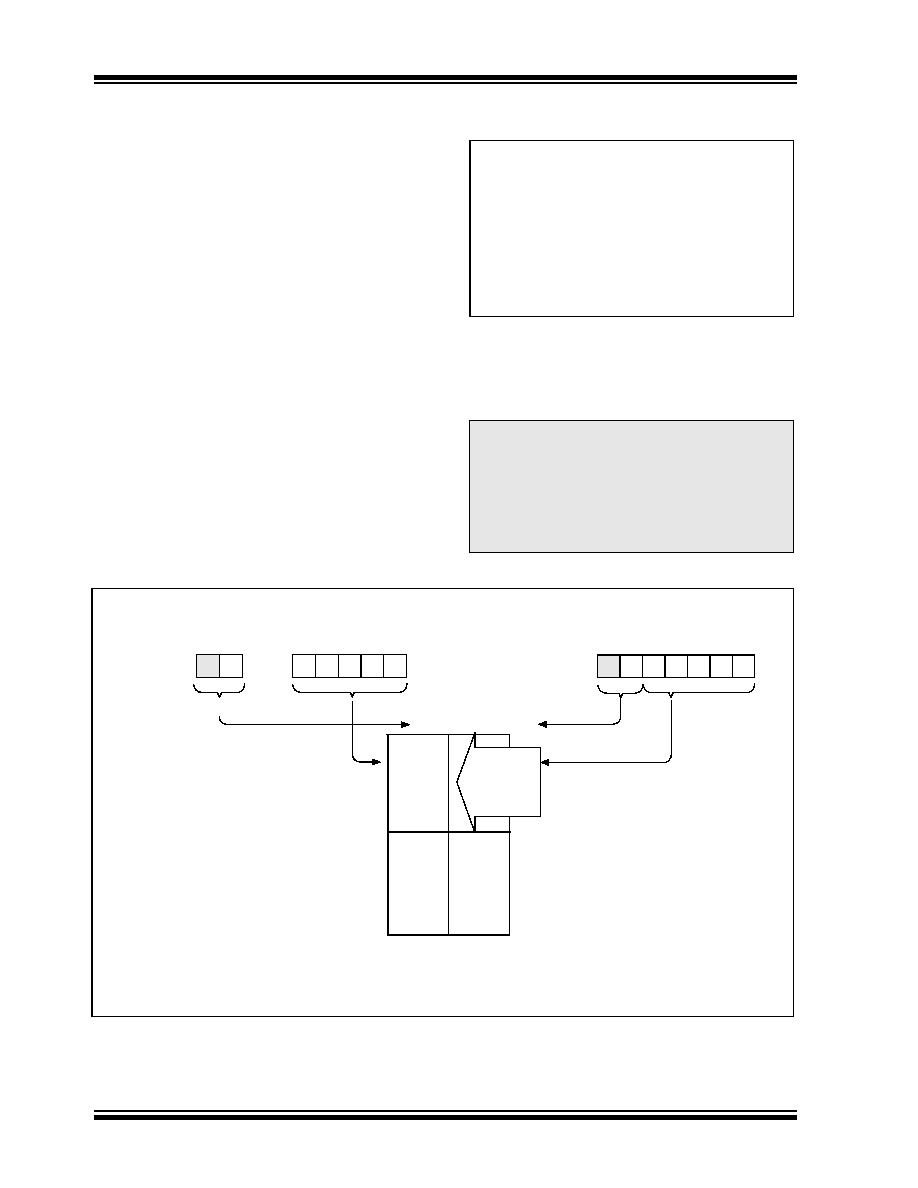- 您现在的位置:买卖IC网 > Sheet目录3896 > PIC16F505T-I/SL (Microchip Technology)IC MCU FLASH 1KX12 14SOIC

PIC12F508/509/16F505
DS41236E-page 28
2009 Microchip Technology Inc.
4.9
Indirect Data Addressing: INDF
and FSR Registers
The INDF register
is
not
a physical
register.
Addressing INDF actually addresses the register
whose address is contained in the FSR register (FSR
is a pointer). This is indirect addressing.
4.9.1
INDIRECT ADDRESSING
Register file 07 contains the value 10h
Register file 08 contains the value 0Ah
Load the value 07 into the FSR register
A read of the INDF register will return the value
of 10h
Increment the value of the FSR register by one
(FSR = 08)
A read of the INDR register now will return the
value of 0Ah.
Reading INDF itself indirectly (FSR = 0) will produce
00h. Writing to the INDF register indirectly results in a
no operation (although Status bits may be affected).
A simple program to clear RAM locations 10h-1Fh
using indirect addressing is shown in Example 4-1.
EXAMPLE 4-1:
HOW TO CLEAR RAM
USING INDIRECT
ADDRESSING
The FSR is a 5-bit wide register. It is used in conjunction
with the INDF register to indirectly address the data
memory area.
The FSR<4:0> bits are used to select data memory
addresses 00h to 1Fh.
FIGURE 4-7:
DIRECT/INDIRECT ADDRESSING (PIC12F508/509)
PIC12F508 – Does not use banking. FSR <7:5> are
unimplemented and read as ‘1’s.
PIC12F509 – Uses FSR<5>. Selects between bank 0
and bank 1. FSR<7:6> are unimplemented, read as
‘1’.
PIC16F505 – Uses FSR<6:5>. Selects from bank 0 to
bank 3. FSR<7> is unimplemented, read as ‘1’.
MOVLW
0x10
;initialize pointer
MOVWF
FSR
;to RAM
NEXT
CLRF
INDF
;clear INDF
;register
INCF
FSR,F
;inc pointer
BTFSC
FSR,4
;all done?
GOTO
NEXT
;NO, clear next
CONTINUE
:
;YES, continue
:
Note 1:
For register map detail, see Section 4.3 “Data Memory Organization”.
2:
PIC12F509.
Bank
Location Select
Bank Select
Indirect Addressing
Direct Addressing
Data
Memory(1)
0Fh
10h
Bank 0
Bank 1(2)
0
4
5
6
(FSR)
00
01
00h
1Fh
3Fh
(opcode)
0
4
5
6
(FSR)
Addresses
map back to
addresses
in Bank 0.
发布紧急采购,3分钟左右您将得到回复。
相关PDF资料
PIC12F509T-I/SN
IC MCU FLASH 1KX12 8SOIC
PIC10F200T-E/OT
IC PIC MCU FLASH 256X12 SOT23-6
006200516230000
CONN FFC/FPC 16POS 1MM R/A SMD
006200516230000+
CONN FFC/FPC 16POS 1MM R/A SMD
40FMN-BMT-A-TF
CONN FMN HSNG 40POS SNGL NOR SMD
0781191309
CONN FFC/FPC 30POS .5MM VERT SMD
046214012010800+
CONN FPC VERTICAL 0.5 MM 12POS
006200514230000+
CONN FFC/FPC 14POS 1MM R/A SMD
相关代理商/技术参数
PIC16F505T-I/SL040
制造商:Microchip Technology Inc 功能描述:MCCPIC16F505T-I/SL040 14 PIN 1.5 KB F
PIC16F505T-I/ST
功能描述:8位微控制器 -MCU 2 KB 72 RAM 12 I/O RoHS:否 制造商:Silicon Labs 核心:8051 处理器系列:C8051F39x 数据总线宽度:8 bit 最大时钟频率:50 MHz 程序存储器大小:16 KB 数据 RAM 大小:1 KB 片上 ADC:Yes 工作电源电压:1.8 V to 3.6 V 工作温度范围:- 40 C to + 105 C 封装 / 箱体:QFN-20 安装风格:SMD/SMT
PIC16F506-E/MG
功能描述:8位微控制器 -MCU 1.5KB 67 RAM 12 I/O RoHS:否 制造商:Silicon Labs 核心:8051 处理器系列:C8051F39x 数据总线宽度:8 bit 最大时钟频率:50 MHz 程序存储器大小:16 KB 数据 RAM 大小:1 KB 片上 ADC:Yes 工作电源电压:1.8 V to 3.6 V 工作温度范围:- 40 C to + 105 C 封装 / 箱体:QFN-20 安装风格:SMD/SMT
PIC16F506-E/P
功能描述:8位微控制器 -MCU 1.5KB FL 67 RAM 12I/O Comp Ext Temp RoHS:否 制造商:Silicon Labs 核心:8051 处理器系列:C8051F39x 数据总线宽度:8 bit 最大时钟频率:50 MHz 程序存储器大小:16 KB 数据 RAM 大小:1 KB 片上 ADC:Yes 工作电源电压:1.8 V to 3.6 V 工作温度范围:- 40 C to + 105 C 封装 / 箱体:QFN-20 安装风格:SMD/SMT
PIC16F506-E/SL
功能描述:8位微控制器 -MCU 1.5KB Flsh 67RM 12IO Comp 8B ADC Ext Temp RoHS:否 制造商:Silicon Labs 核心:8051 处理器系列:C8051F39x 数据总线宽度:8 bit 最大时钟频率:50 MHz 程序存储器大小:16 KB 数据 RAM 大小:1 KB 片上 ADC:Yes 工作电源电压:1.8 V to 3.6 V 工作温度范围:- 40 C to + 105 C 封装 / 箱体:QFN-20 安装风格:SMD/SMT
PIC16F506-E/ST
功能描述:8位微控制器 -MCU 1.5 KB Flash 67RAM12 I/O 8bit ADC RoHS:否 制造商:Silicon Labs 核心:8051 处理器系列:C8051F39x 数据总线宽度:8 bit 最大时钟频率:50 MHz 程序存储器大小:16 KB 数据 RAM 大小:1 KB 片上 ADC:Yes 工作电源电压:1.8 V to 3.6 V 工作温度范围:- 40 C to + 105 C 封装 / 箱体:QFN-20 安装风格:SMD/SMT
PIC16F506-I/MG
功能描述:8位微控制器 -MCU 1.5 KB Flash 73 RAM 12 I/O RoHS:否 制造商:Silicon Labs 核心:8051 处理器系列:C8051F39x 数据总线宽度:8 bit 最大时钟频率:50 MHz 程序存储器大小:16 KB 数据 RAM 大小:1 KB 片上 ADC:Yes 工作电源电压:1.8 V to 3.6 V 工作温度范围:- 40 C to + 105 C 封装 / 箱体:QFN-20 安装风格:SMD/SMT
PIC16F506-I/P
功能描述:8位微控制器 -MCU 1.5KB 72 RAM 12 I/O Ind Temp PDIP14 RoHS:否 制造商:Silicon Labs 核心:8051 处理器系列:C8051F39x 数据总线宽度:8 bit 最大时钟频率:50 MHz 程序存储器大小:16 KB 数据 RAM 大小:1 KB 片上 ADC:Yes 工作电源电压:1.8 V to 3.6 V 工作温度范围:- 40 C to + 105 C 封装 / 箱体:QFN-20 安装风格:SMD/SMT